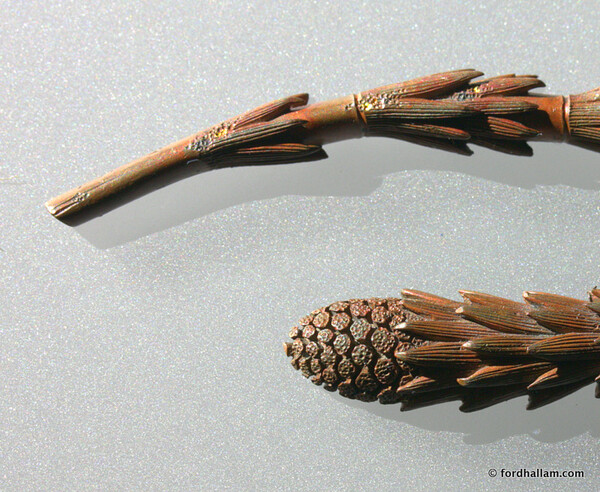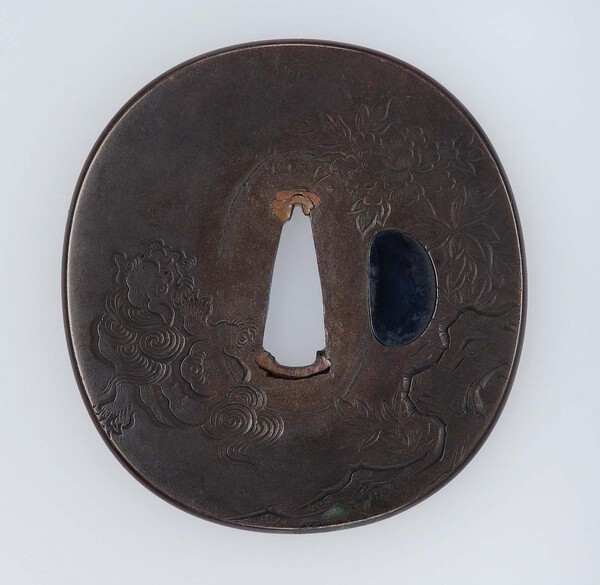-
Posts
3,091 -
Joined
-
Days Won
78
Content Type
Profiles
Forums
Events
Store
Downloads
Gallery
Everything posted by Ford Hallam
-
If it's 'katana mei' it's probably a katana... maybe. The converse contradiction would be a tachi-mei on katana Hizen-to. It's never a 'sure thing' to rely on absolute rules when discussing any aspect of Nihonto. Katana / tachi distinction is never solely down to length.
-
Jean, nickel silver or German silver was actually 'invented' in China before it was known in Europe. It was known as Paktong, white copper. It's possible some made its way to Japan but I doubt it. I'm still not convinced it's silver though, perhaps nickel silver is another option. I have a sneaky suspicion it's a modern replacement too. Can we see the whole koshirae, please? It might offer some context.
-
James, silver is very nearly 4 times heavier than aluminium. If it was aluminium you'd barely feel any weight in your hand :-) so I reckon you could discount that possibility. Caustic soda is pretty corrosive on aluminium but won't effect silver.
-
Might be aluminium. I don't see any sulphides and that greenish/grey mottling 'feels' more like an aluminium oxide.
-
Thank you Morita San, I was wondering who would realise I had put the answer there :-)
-
Jean, yes, the scouring horsetail would be the tokusa - equisetum hyemale. As you say, used for it's abrasive qualities. This one, though, is the tsukushi- equisetum arvense and is the edible variety, and symbolic of spring or early March apparently.
-
Not cast, Stephen...hush your mouth Classic uchidashi but with pretty thick copper, casting copper is notoriously complicated because molten copper can absorb up to 100% its own volume in oxygen rendering it a useless sponge. I can't think of a single pre-modern cast copper artefact actually. Lost wax casting dates back to the very beginnings of metalworking almost everywhere. Hakogaki reads Tsukushi. Tsukushi -Field horsetail -Equisetum arvense Ian, it's tokusa that is used to finish wood.
-
I've treasured this pair of copper menuki for nearly 20 years. For me they are real 'metalworkers metalwork'. The techniques used to create the illusion of a fern are very clever and skilful in the way they make complete use of the properties of the copper to be manipulated and worked. They depict 'tsukushi' ferns and were made sometime in the mid 18th century (circa 1750 ish) . Although not by one of the first rank great masters he was the leading student of one of them. The longer fern is a little over 3 inches in length, they're signed, mei and kao, and the box is signed by a famous appraiser. I won't offer any more clues as to the makers identity just yet so have a ponder and make a suggestion as to their author. edited to add, not techniclly a fern, merely a relative, but they are cooked in spring dishes with ferns :-p
-
I've known Richard Adams for over 23 years and know him to be a skilful craftsman, a natural artist and a pretty decent bloke...if a little reclusive. In fact I think it accurate to say that Richard was the first non-Japanese ever to submit work to the NBTHK competition. He achieved a nyusen for a pierced and carved tsuba in iron of a wild English rose and thorny branches. He's pretty adept at almost all aspects of sword restoration, including his speciality, habaki of all types, shirasaya, tsukamaki and urushi.
-
why send the box in the first place? And panic over folks ...this scratch can be made to magically disappear. Back in the day traditionally trained craftsmen in old Japan did this sort of repair every day.
-
No We have no idea what tools were used when. This is merely someone's guesswork and not based on any actual evidence. As for yose-tagane it's a type of punch, that might be used to displace metals as in the example. It's not really special but pretty much one of the more basic tools of the metalworker. It has a variety of names too, depending on the workshop.
-

Ezo-Esque (Ainu) Design Tosogu Engraved Katakiri-Bori Style
Ford Hallam replied to jamesicus's topic in Tosogu
I'm afraid I can see no Ainu influence in the kata-kiri work. What it appears to me to be is merely a very poorly executed version of a fairly generic Yokoya school style peony flower. Here's an example by Yokoya Soyo II that shows what the flower ought to look like. This one's in the MFA Boston. -
it's Friday so I'll let you off
-
-
well that's no fun...no counter argument? you guys are no fun
-
In my opinion the metal parts of this assembly were not made by the same person or studio nor were they made as part of a overall design concept. This is a loose collection of parts with a tenuous link to the sea or aquatic life...and a fresh water turtle (suppon). The inclusion of that turtle suggests the koshirae was intended for an uninformed audience who wouldn't notice the turtle is the odd one out. I doubt that any wealthy Edoite would have made such a daft mistake especially as they were a popular delicacy. The fuchi kashira are very obviously mis-matched and while the menuki are copper they way they are finished compared to the worn gilt on the octopus suggests that they were also originally unconnected with any of the other parts. The tsuba is mildly interesting in that it seems to feature enamel on the rough side but it's not a particularly fine piece of craftsmanship, imo. The kurikata is far better in terms of conception and technique than the tsuba. I think that bit is probably the best part :-) It's already been pointed out that the kozuka is possibly a replacement but given that this koshirae is obviously a mish mash of disparate parts I see no reason to think this isn't what was originally chosen for the set.
-
The fuchi is signed Kenkosai Kazutomo, a student of the Omori school.
-
No obvious answers here, . I would hesitate to tackle such a demanding copy and I very much doubt you'll find anyone in Japan experienced in this type of work or working even at this level of fairly generic Edo period work. Has anyone seen inlay work as delicate as that gold fence, done in modern times? Bare in mind the fuchi is probably around 12mm high, which would make the fence only a couple of millimetres high.
-

What Is The Theme Of These Menuki Supposed To Mean?
Ford Hallam replied to Heringsdorf's topic in Tosogu
I think it's a fox too, which suggests Inari Okami. A sheaf of rice might further suggest prosperity, rice formed the basis of wages for the warrior class and to a great extent the whole economy. What appears to be a hunter is, I think, a bird scarer. Perhaps to safeguard the crops. And the crescent moon, a harvest moon maybe? -
I couldn't recommend any of the commercially available silver 'plating' solutions. These contain silver nitrate in solution but only leave a extremely thin flash coating of silver that wears off in no time. And it doesn't matter how much you rub on either, the way it works simply doesn't allow for the silver to build up. I wouldn't ask a high street/mall jeweller to gold plate anything either. Their electroplating set-ups tend also to be fairly lightweight in terms of actual gold thickness deposit. For something like a habaki I'd recommend a commercial plating service, they can easily be found on-line, and ask for 5 microns thick plating. I reckon that should last at least 10 years or more. Avoid any of the various gold alloy colours on offer as they don't look anything like proper Japanese metalwork golds and also avoid the 'special' extra hard gold plating for the same reason.
-
Surely whether a tsuba was intended for a katana or not might be judged from the size of the seppa-dai? which is itself derived from the size of the blade the handle was intended to accommodate.
-
As Alan says this is typical for Sanemasa. I've restored a couple just like this. The workmanship and general style is absolutely correct in the ebay example imo. The asking price, on the other hand, seems just a little bit ambitious.
-
Chris, There are probably a few thousand collectors worldwide and tens of thousands of tsuba in private hands. I've seen dozens of oni on tosogu myself. I can think of at least 3 or 4 on the pieces I have here in my study right now.
-
Chris, you can search many on-line collections (images in great quality) at The MFA Boston, The British Museum, The Met,NY, The Ashmolean, Oxford and many others. There and literally 1000's of images to search through.
-
Just to explain: I won't simply alter the appearance of pieces just for the sake of it or because a client has a preference. In this case it was very clear that the gold nunome had been added sometime in the past 50 years or so (the cut ground was unnaturally sharp and crisp compared to the overall surface condition of the iron for it to have been done in the late Edo period) and was merely an attempt to make the tsuba more sell-able. And as I remarked to Grev, pieces like this can easily be underestimated. The steel/iron is actually very well processed and forged with a fine masame evident in the rim. The piercing work is something we simply have to marvel at today.













